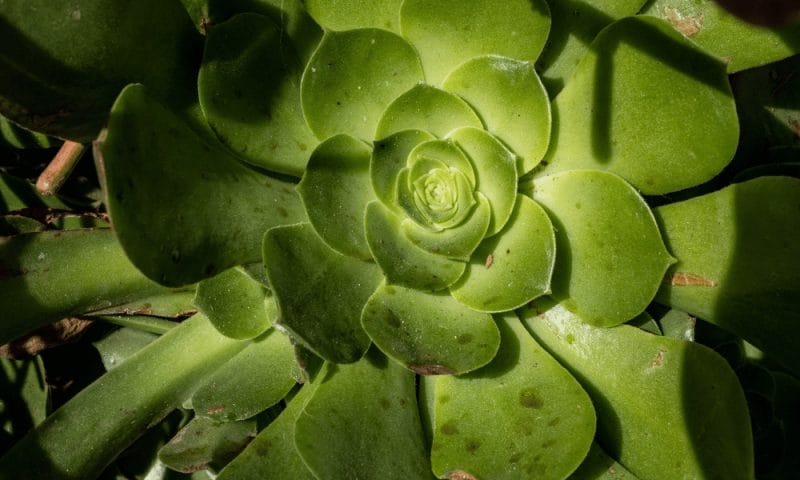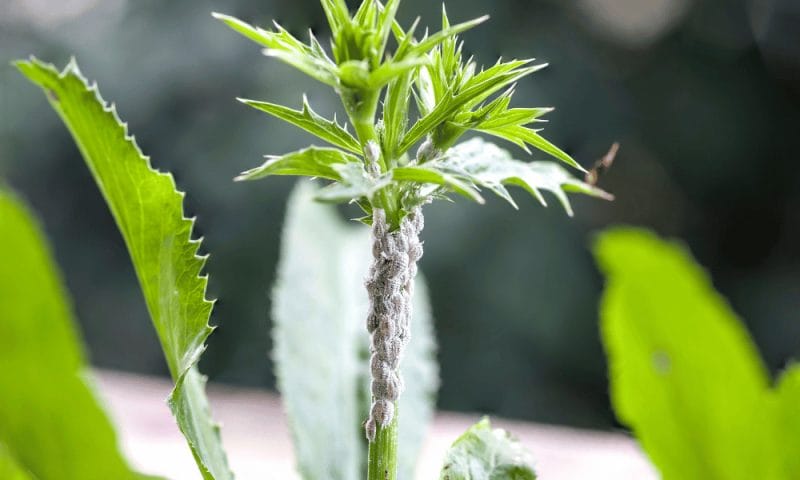
Do you have a succulent plant growing beautifully, but its leaves suddenly shriveled? Come on, I can't be the only one. This can be a concerning sign, especially if you're a new succulent enthusiast. Don't worry, as there are many reasons why succulent leaves shrivel, and most of them are fixable.
This post will cover the most common causes of shriveled succulent leaves and how to save your plant.
If you're new to gardening, succulents are an excellent type of plant to start with. They only require a little care, come in many different shapes, sizes, and colors, and can go for months without water. But if you suddenly notice your once vibrant succulent leaves shriveling up like raisins, don't worry; we've got you.
Table of Contents
Understanding Overwatered and Underwatered Succulents
A key element in maintaining your succulent's health is comprehending the distinction between overwatered and underwatered plants. Overwatered succulents can result in root rot, as shown by mushy stems, brown spots on leaves, and, eventually, the plant's death. On the other hand, underwatered succulents will display shriveled leaves, dry skin, and a translucent appearance. Giving your succulent water, light, and soil is essential to avert either outcome.
The Importance of Drainage Hole
One frequent explanation for shriveling succulent leaves is inadequate drainage. If the container's bottom lacks a drainage hole, too much water will pool, resulting in root rot. This can also occur if you put a saucer under the pot, capturing moisture and producing root rot. I am a fan of using saucers under pots to prevent furniture damage. If you decide to use saucers, keep an eye on the saucer to ensure it doesn't collect water and ensure that your pot has a drainage hole.
The Right Soil for Your Succulent
The soil mix and moisture levels of your succulent's pot can also impact the health of its leaves. Use a fast-draining succulent mix, and be mindful of the watering schedule. A moisture meter can help determine when to water your succulent. A good soak followed by allowing the soil to dry out entirely between waterings is the best way to ensure your succulent has enough moisture.
Balancing Light and Water
Light and water are essential factors contributing to your succulent plant's health. Succulents need bright light, but too much direct sunlight can lead to sun damage and shriveled leaves. The best way to know if your succulent is getting enough light is by observing the color and size of new leaves. Your succulent needs more light if they are smaller and lighter in color. On the other hand, too little light will cause the lower leaves to shrivel, and new leaves will be smaller and lighter in color.
The same goes for water. Succulents store water in their leaves, so they must not over-water or under-water themselves. The best way to know if your succulent needs water is by checking the pot's weight and the soil's top. If the soil feels dry to the touch, it's time to give your succulent a good drink of water. However, if the pot feels heavy and the top of the soil is moist, it's best to wait a few days before watering. A moisture meter can also be useful in determining the soil's moisture level.
Causes of Shriveled Succulent Leaves
Succulents are tough, but even they have their limits. Here are the most common causes of shriveled leaves:
Overwatering

Although you may be trying to be helpful by giving your succulent a lot of water, it can actually hurt it more than help. Overwatering is one of the most common reasons for shriveled leaves. When your plant's roots are submerged constantly, they can't get the air they need to breathe. As a result, the leaves start to shrivel up.
3 Signs of Overwatering
Hopefully, you're not in the category of overwatering your succulent plants. If you're not sure, use look for the the three symptoms below:
- Yellow or brown leaves: This can indicate root rot, a common problem caused by overwatering.
- Soft and mushy leaves: If your leaves feel soft or mushy to the touch, this can also be a sign of overwatering.
- A mushy stem: If the stem of your succulent feels soft or mushy, this is a sure sign that it's getting too much water.
How to Fix Overwatered Succulents
If you suspect that you have overwatered your succulent, here are the steps you can take to resolve the issue:
- Stop watering: First, you should stop watering your succulent. You want to give it a chance to dry out, so it can recover.
- Check the soil: The next step is to check the soil. If it's still very moist, you may need to wait a few days before watering again.
- Remove any dead leaves: If there are any dead leaves on your succulent, remove them. This will help to prevent the spread of any diseases that may have caused the shriveled leaves.
- Re-pot: If the soil is still very wet and there are signs of root rot, you may need to re-pot your succulent into the new soil. Make sure to use a fast-draining soil mix and a pot with a drainage hole.
Underwatering
On the other hand, if you're not giving your succulent enough water, it can also lead to shriveled leaves. Succulents store water in their leaves, so if they're not getting enough water, they'll start to shrivel up as a survival mechanism.
3 Signs of Underwatering
Here's what to look for if you think you're underwatering your succulent:
- Wrinkled leaves: If your succulent leaves are wrinkled and look like they are drying out, this could be a sign of underwatering.
- A limp stem: If the stem of your succulent is limp and drooping, it's likely not getting enough water.
- Brown tips: If the tips of your succulent leaves turn brown, this can also indicate a lack of water.
How to Fix Underwatered Succulents
Here's what you can do if you suspect that you're underwatering your succulent:
- Water: First, you should give your succulent a good drink, but not too much. Ensure you're watering the plant enough, so the soil is moist but not soaking wet.
- Adjust watering schedule: If you need clarification on how often you should water your succulent, you can use a moisture meter to help determine when it's time to water again. You may also need to adjust your watering schedule based on the amount of light and heat your succulent receives.
- Provide enough light: Make sure that your succulent is getting enough light. If not, you may need to move it to a brighter location or provide artificial light.
- Check for pests: If you still see signs of shriveled leaves after watering and adjusting the lighting, check for pests. Pests like mealybugs and spider mites can cause damage to your succulent, so it's essential to treat them as soon as possible.
Sunburn

Just like us, succulent plants can get sunburned if they’re in too much direct sunlight. Too much direct sunlight can cause the leaves on your succulent to shrivel. Make sure to put your plant in an area that gets enough light but isn’t fully exposed to the sun all day. A bright location with partial shade or a few hours of morning and afternoon sun.
Symptoms of Sunburn
If you think your succulent is getting too much sun, look for these symptoms:
- Yellow or brown patches: It could be a sunburn sign if your succulent has yellow or brown patches on its leaves.
- Leaves facing away from the sun: If your succulent leaves face the sun, this can also indicate sunburn.
- Leaves that are getting smaller: If your succulent leaves are getting smaller, this can also be a sign that it's getting too much sun.
How to Fix Sunburned Succulents
If you think your succulent is getting too much sun, here's what you can do:
- Move to a shadier location: First, move your succulent to a shadier spot. You want to ensure that it's not getting too much direct sunlight so that it can recover.
- Provide partial shade: If you can't move your succulent to a shadier location, you can provide it with partial shade. You can use a sheer curtain or shade cloth to filter the sunlight.
- Monitor sun exposure: Pay close attention to how much sun your succulent is getting and adjust its location as needed.
Pests

Unfortunately, pests like mealybugs, spider m, and scale insects can also cause your succulent leaves to shrivel. These pests can suck the sap from the leaves, causing them to dry up and wrinkle.
Symptoms of Pests
If you suspect pests might be the cause of your succulent's shriveled leaves, look for these symptoms:
- Sticky residue on the leaves: If you notice a sticky residue on your succulent leaves, this could signify pests.
- Small webs or clusters on the leaves: If you see small webs or clusters on your succulent leaves, this could indicate the presence of spider mites.
- Brown or yellow spots on the leaves: If your succulent leaves have brown or yellow spots, this could signify scale insects.
Steps to Resolve Pest Issues
Here's what you can do to resolve pest problems on your succulent:
- Inspect the plant: Check your succulent closely for any signs of pests, such as tiny insects or sticky residue on the leaves.
- Remove pests by hand: If you find pests, try to remove them by hand or with a soft cloth.
- Use insecticidal soap: If you can't remove the pests by hand, you can use insects.
Conclusion
In conclusion, succulent plants are easy to take care of and don't require much maintenance. However, they can still have problems, like shriveled leaves. You must first understand the root causes, such as overwatering, underwatering, sunburn, and pests, to fix the issue.
You can help your succulent heal and do well with love and attention. Paying close attention to your plants and learning their ideal care practices is a good idea whether you're an experienced gardener or just starting.
Now that the mystery is solved. Now, use these 7 Tips to Accelerate The Growth of Your Succulent Plants



